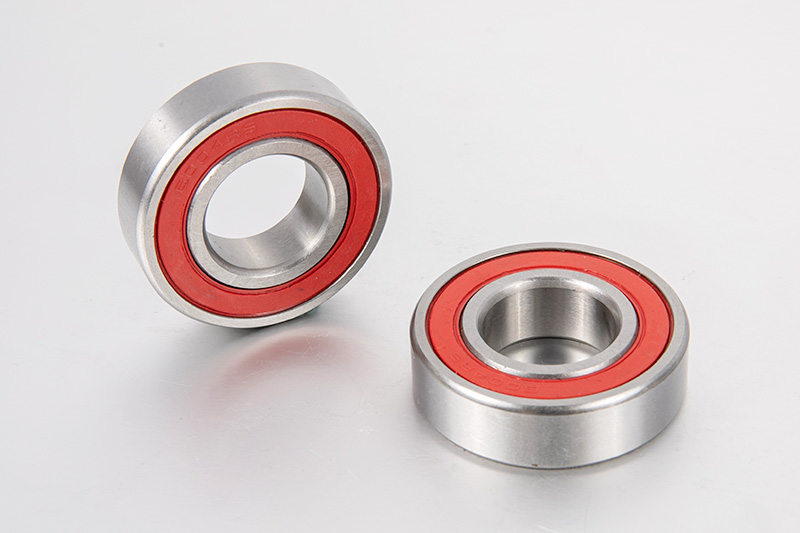Series 1600 Chrome Steel Deep Groove Ball Bearing
Product Overview The Series 1600 Deep Groove Ball ...
Deep groove ball bearings are widely used in industrial equipment, motors, home appliances, agricultural machinery and automobiles due to their simple structure, low cost, low friction and stable load capacity. Bearing failure is one of the main causes of equipment failure. Bearing failure not only shortens the life of the equipment, but also may cause expensive repair costs and downtime losses. It is crucial to promptly identify common types of bearing failure and take effective preventive measures.

1. Common deep groove ball bearing failure types
a. Fatigue Failure / Spalling
Detailed description:
Fatigue failure is caused by microcracks on the rolling contact surface of the bearing under long-term stress, which eventually leads to material spalling. This spalling usually occurs on the surface of the inner ring, outer ring or rolling element, forming small pits (pitting).
Common causes:
Overload operation
Continuous vibration or impact load
Improper installation leads to stress concentration
Insufficient lubricating oil film leads to direct friction between contacting metals
Identification method:
Periodic abnormal noise during operation
Increased bearing vibration frequency
Metal particles found in lubricating oil
Increased operating temperature
b. Lubrication Failure
Detailed description:
Lubrication failure is one of the most common causes of failure. Lack of lubricant or deterioration of lubricant performance will lead to direct contact between metals, resulting in severe friction and wear.
Common causes:
Insufficient or excessive amount of lubricant
Aging or deterioration of lubricant
Using a lubrication type that does not match the working conditions
Not relubricating on time
Identification method:
Discoloration on the bearing surface (usually blue-black)
Increased running resistance
Increased noise
Burns or wear marks on the internal surface
c. Contamination
Detailed description:
Contamination refers to the entry of dust, moisture, corrosive chemicals or other particles into the bearing, causing abnormal wear of the rolling elements and tracks.
Common causes:
Poor sealing
Inadequate cleaning during installation
Harsh operating environment
Impurities mixed in the lubricant
Identification method:
Scratches and abrasions on the track surface
Uneven wear
Traces of foreign particles
Loud and irregular noise
d. Corrosion
Detailed description:
Bearings are prone to corrosion when exposed to humid or chemically corrosive environments. Corrosion destroys the surface structure and aggravates the development of fatigue cracks.
Common causes:
Seal failure
Moisture during use or storage
Contact with acidic and alkaline substances
Electrochemical reaction causes micro-current corrosion
Identification method:
Rust or oxide layer on the inner and outer ring surfaces
Rough surface of rolling element
Muffled sound during operation
Increased water content in the lubricant used
e. Electrical Erosion / Fluting
Detailed description:
When the motor or inverter is working, the current may pass through the bearing, forming partial discharge, leaving unique corrugated or pit-like marks on the raceway, which is the electrical corrosion phenomenon.
Common causes:
Poor motor grounding
Frequent start-stop or high-frequency variable frequency control system
Static discharge is not led out through the bypass
Identification method:
Regular ripples appear on the raceway (called the "washboard" effect)
Harsh and continuous noise
Obviously abnormal bearing vibration mode
Abnormal temperature rise at the motor bearing end
f. Misalignment / Mounting Errors
Detailed description:
Using improper tools during installation or misalignment of the shaft and bearing seat will cause uneven load distribution, accelerate local wear and even cause early fatigue.
Common causes:
Using hammer installation
Not using special tools (such as heaters)
Eccentricity or deformation of the shaft or housing
Too loose or too tight fit
Identification method:
Severe local wear
The bearing cannot rotate freely after installation
Non-linear noise appears during operation
Early failure with obvious directionality
2. Diagnostic Techniques
a. Vibration Analysis
Using a spectrum analyzer to detect specific frequency vibrations generated by the bearing during operation can effectively identify fatigue, wear or defects.
b. Acoustic Emission Monitoring
Capture high-frequency sounds emitted by cracks or metal peeling on the bearing surface for early warning.
c. Thermal Imaging
Use an infrared thermal imager to check the temperature distribution of the bearing to determine whether there is friction overheating or poor lubrication.
d. Oil/Lubricant Analysis
Extract grease samples to analyze their composition, particle content and contamination level to determine the operating status of the bearing.
e. Visual Inspection
Check the color, wear marks, raceway morphology and other visible signs of the bearing after shutdown.
3. Preventive Measures
a. Proper lubrication
Select the appropriate lubricant/grease as recommended by the manufacturer
Avoid under- or over-lubrication (over-lubrication can cause overheating)
Replenish or replace lubricants regularly as planned
b. Clean installation environment
Use clean tools and gloves to prevent foreign matter from entering
Do not unpack the bearing packaging until just before installation
Use a dust-free workbench for installation
c. Use high-quality seals
In humid or dusty environments, choose double-lip seals or protective covers
Regularly check the seals for aging and damage
d. Use special installation tools
Avoid hitting the bearing with a hammer
Use a bearing heater for hot installation to ensure uniform expansion of the bearing
Use a puller for removal to avoid damage
e. Ensure accurate alignment
Use a laser alignment instrument or micrometer to ensure that the bearing is installed concentrically
Check the base and shaft for deformation
f. Deal with current leakage
Install a shaft current bypass for the motor (such as a carbon brush or current winding coil)
Ensure that the equipment is well grounded, especially in inverter drive systems